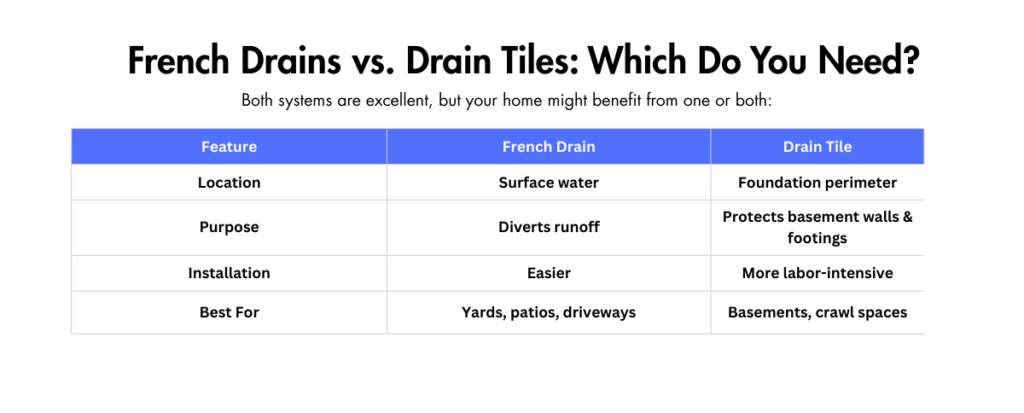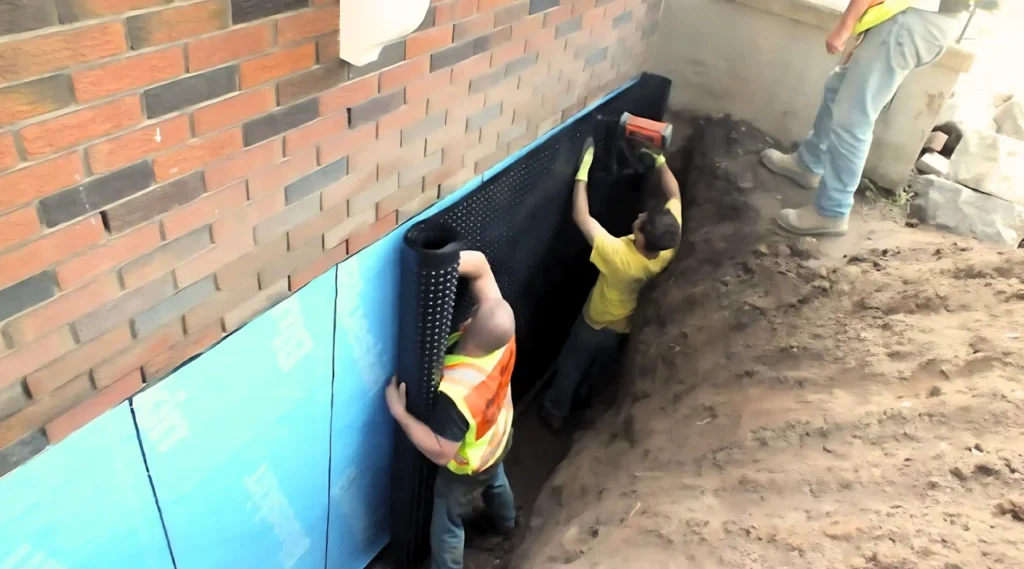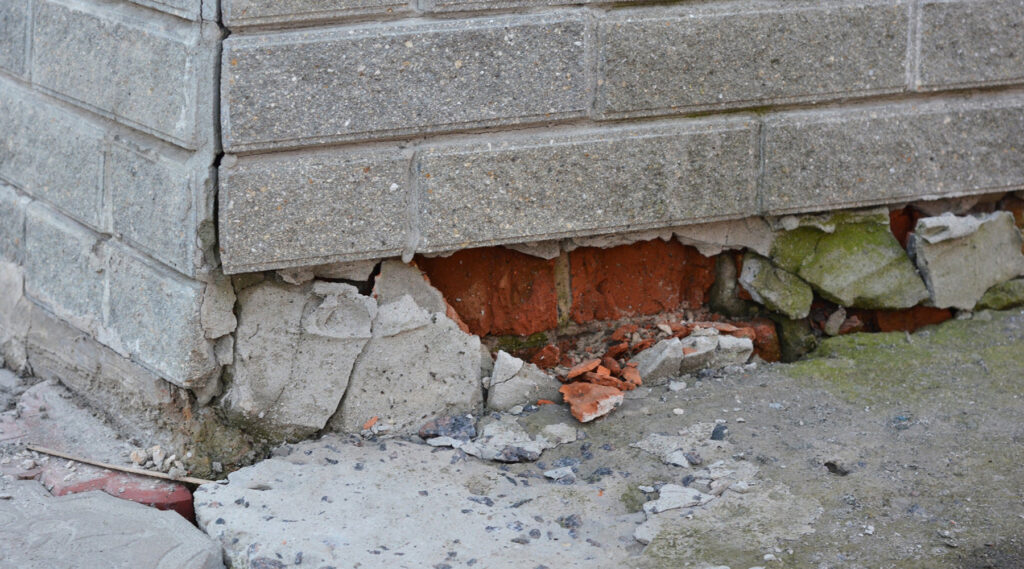A wet basement or a damp crawl space can be more than just an annoyance; they can lead to serious foundation problems over time. That’s where French drains and drain tiles come into play. These drainage solutions help redirect water away from your home’s foundation, reducing hydrostatic pressure, preventing leaks, and keeping your basement dry. If you’ve been wondering how to protect your foundation and maintain a dry, healthy home, installing these systems is one of the smartest moves you can make.
What Are French Drains and Drain Tiles?
French drains are trenches filled with gravel and a perforated pipe that channel water away from your home. They collect surface water and groundwater and guide it to a safe discharge point.
Drain tiles, sometimes called footing drains, are pipes installed around the perimeter of your foundation. They collect water at the base of the foundation walls and divert it away from your home. While the terms are sometimes used interchangeably, French drains usually handle surface water, and drain tiles focus on water at the foundation level.
Together, these systems form a proactive barrier against water intrusion, helping maintain the integrity of your foundation.
How Water Affects Your Foundation
Water is surprisingly robust. When it accumulates near your foundation, it can:
- Increase hydrostatic pressure, pushing against basement walls.
- Cause cracks in concrete and masonry over time.
- Promote mold and mildew growth in damp crawl spaces.
This leads to soil erosion, undermining your foundation’s stability. Even small amounts of water left unmanaged can lead to expensive repairs. That’s why proper drainage using French drains and drain tiles is essential not only for foundation protection but also as part of adequate crawl space waterproofing solutions that keep your home safe and dry.
How Do I Know If My House Needs a French Drain?
If you’re dealing with water problems around your home, you might be wondering whether a French drain is the right solution. French drains move water away from areas where it can cause damage, such as your basement, foundation, or yard.
Here are some common signs that your house might need a French drain:
1. Water in Your Basement or Crawl Space
If you notice water seeping into your basement after heavy rain, or if the air down there feels damp and musty, it could mean that water is collecting around your foundation. A French drain can help move that water away and keep your basement dry.
2. Pooling Water in Your Yard
Do you see standing water in your yard for hours or even days after it rains? Poor drainage could be the cause. A French drain installed underground can help guide that water away to a safer place, like a storm drain or dry well.
3. Soggy or Mushy Lawn
If parts of your lawn are always wet and hard to mow or walk on, that’s a sign that water isn’t draining correctly. A French drain helps dry out those areas by giving water a path to flow through gravel and pipes.
4. Cracks in Your Foundation
Water collecting around your home’s foundation can lead to cracks over time. If you’re seeing cracks in basement walls or floors, it might mean water pressure is building up around your home. A French drain can relieve that pressure.
5. Mould or Mildew Smells Indoors
A damp smell inside your home, especially near the basement or lower levels, could mean water is getting inside. Mold and mildew thrive in moist environments, so improving drainage with a French drain can help prevent those issues.
6. Soil Erosion Near Your Foundation
If rainwater is washing soil away from around your home, it could cause long-term damage to your structure. A French drain can help control how water flows and protect your foundation.
French Drains: How They Protect Your Home
- A well-designed French drain:
- Collects surface water before it pools near your foundation.
- Diverts water to a safe location, like a storm drain or lower yard area.
- Prevents soil saturation, reducing pressure on basement walls.
- Works in conjunction with gutter systems to enhance overall water management.
- French drains are versatile.
They can be installed along driveways, near patios, or along the foundation itself. The key is proper grading and placement to ensure water flows naturally away from your home.
- Drain Tiles: Strengthening the Foundation
While French drains manage surface water, drain tiles tackle the water that collects underground, directly around your foundation footings. Their benefits include:
Basement waterproofing: Drain tiles prevent seepage through cracks or porous walls by intercepting water at the foundation level.
Crawl space protection: They keep crawl spaces dry, preventing wood rot, mold, and structural damage.
Soil stabilization: Properly installed drain tiles reduce soil movement and settlement, protecting your foundation from shifting. Installing drain tiles often involves digging around the foundation and adding a perforated pipe system that leads water to a sump pump or exterior drainage outlet.

For homes in Gainesville, Georgia, where rainfall can be significant, many homeowners benefit from combining both systems to ensure complete protection against water damage.
Installation Tips for Maximum Effectiveness
To get the most from your French drain or drain tile system:
- Ensure proper slope: Water must flow away from your foundation naturally.
- Use geotextile fabric to prevent soil from clogging the drain.
- Maintain a clear discharge point, such as a dry well or storm drain.
- Connect to sump pumps where necessary for added protection.
- Regular maintenance: Inspect for blockages, sediment buildup, and damage.
Even small mistakes during installation can reduce effectiveness, so professional installation is often the best choice.
How Long Will a French Drain Last?
A French drain is a great way to manage water around your home. It helps move water away from areas where it might cause problems, like your basement or yard. But many people wonder: how long does a French drain actually last?
The good news is that a well-installed French drain can last 30 to 40 years, or even longer. However, this depends on a few important factors.
1. Proper Installation
If the French drain is installed correctly with the right slope, good-quality materials, and proper gravel and filter fabric, it will work more effectively and last much longer. Poor installation can lead to problems much sooner.
2. Quality of Materials
The pipe used in the drain and the gravel surrounding it must be durable. Using high-quality, perforated pipes and the right type of gravel can help prevent clogs and damage over time.
3. Soil and Root Conditions
If you have many trees nearby, roots may grow into the drain over time and block it. Also, if your soil has many fine particles, like clay or silt, it can slowly clog the system if no proper filter fabric is used.
4. Regular Maintenance
Like any part of your home, French drains need some care. If you check the drain every once in a while and remove any buildup of dirt or leaves near the opening, it will stay in better shape. Some homeowners also flush the system with water occasionally to keep it clear.
Integrating With Other Basement Waterproofing Methods
French drains and drain tiles are most effective when paired with other basement-waterproofing methods:
- Sealants and waterproof coatings for foundation walls.
- Crawl space waterproofing, including vapor barriers and encapsulation.
- Gutter and downspout extensions to manage roof runoff.
Together, these solutions form a multi-layered defense against water damage.
Benefits for Homeowners
Investing in French drains and drain tiles provides tangible advantages:
- Reduced risk of foundation cracks and costly repairs.
- Lower chance of basement flooding and water damage.
- Healthier indoor air quality by preventing mold and mildew.
- Increased property value due to improved structural protection.
Take Action Before Water Strikes
Water damage is one of the leading causes of foundation problems in Georgia homes. Installing French drains and drain tiles proactively protects your home, preserves your investment, and keeps your basement and crawl space dry year-round.
If you want to safeguard your foundation and ensure long-term protection, contact Tri-State Waterproofing today. Our experienced team in Gainesville, Georgia, specializes in installing French drains, drain tiles, and comprehensive basement-waterproofing methods to keep your home safe and dry. Don’t wait for the next rainstorm; take action now and protect your home from costly water damage.
FAQs
1. How does a French drain work?
Water seeps into the gravel, enters the perforated pipe, and flows through the pipe (sloping downhill) to a discharge point. This helps prevent water accumulation near foundations, reducing problems like moisture, flooding, and damage.
2. How deep and wide should a French drain be?
The depth is often 18‑24 inches (sometimes a bit more or less, depending on the situation) to allow enough room below ground level and avoid surface disturbances. Width depends on how much water you need to move; typically enough to accommodate the pipe plus gravel around it. (A width of around 12‑18 inches is standard in many setups.)
3. What slope do I need for a French drain?
You need a slight but consistent slope so water moves away naturally. A slope of about 1% (i.e., 1 unit drop per 100 units distance) is good. Some sources show ranges from 0.5‑3%, depending on soil type, pipe, etc.
4. Can I connect downspouts to a French drain?
Sometimes yes, but with caution. Downspouts bring a lot of water quickly. If you connect them, you must ensure the French drain is sized to handle the extra flow and has a proper discharge point. Also, avoid letting debris from gutters clog the pipe. Using non‑perforated pipe for the downspout, leaf guards, and screens helps.
5. How often should a French drain be maintained or cleaned?
You’ll want to check it at least once a year: ensure the outlet is clear and there’s no buildup of debris or roots. Depending on soil, local conditions, and usage (how much water runs into it), more thorough cleaning might be needed every few years.


